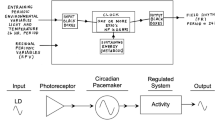Abstract
MANY functions of multicellular organisms follow such a consistent daily periodicity, even in constant environmental conditions, that it has been natural to postulate control by a single internal clock. But some observations are explained only by the joint action of several circadian oscillators1,2. Experimental confirmation of such a system has been obtained for several species3,4. For example, two rhythms in an organism may have independent period lengths, even in steady state. This internal desynchronisation is thought to have been demonstrated when the phase difference between the two rhythms exceeds 360° (ref. 5). It has been described for humans1 and non-human primates6. The possession of pairs of organs by bilaterally symmetrical metazoans suggests an anatomical basis for multioscillator organisation. So far, however, evidence has been based on surgical isolation of the oscillators of molluscs7 and crustaceans8, or indirectly on ablation experiments with insects9–11. We have now obtained direct evidence with beetles, by demonstrating internal desynchronisation between the right and left sensitivity rhythms in the compound eyes, without surgical intervention.
Similar content being viewed by others
References
Aschoff, J. Science 148, 1427–1432 (1965).
Jacklet, J. W. & Geronimo, J. Science 174, 299–302 (1971).
Gwinner, E. Science 185, 72–74 (1974).
Pittendrigh, C. S. & Daan, S. J. comp. Physiol. 106, 333–355 (1976).
Wever, R. Int. J. Chronobiol. 1, 371–390 (1973).
Sulzmann, F. M., Fuller, C. A. & Moore-Ede, C. Comp. Biochem. Physiol 58 A, 63–67 (1977).
Jacklet, J. W. Science 164, 562–563 (1969).
Sanchez, J. A. & Fuentes-Pardo, B. Comp. Biochem. Physiol. 56 A, 601–605 (1977).
Nishiitsutsuji-Uwo & Pittendrigh, C. S. Z. vergl. Physiol. 58, 14–46 (1968).
Loher, W. J. comp. Physiol. 76, 173–190 (1972).
Page, T. L., Caldarola, C. & Pittendrigh, C. S. Proc. natn. Acad. Sci. U.S.A. 74, 1277–1281 (1977).
Fleissner, G. J. comp. Physiol. 91, 399–416 (1974).
Fleissner, G. J. comp. Physiol. 118, 93–99 (1977).
Koehler, W. K. thesis, Univ. Frankfurt (1973).
Wada, S. & Schneider, G. Z. vergl. Physiol. 58, 395–397 (1968).
Jacklet, J. W. in Biochronometry (ed. Menaker, M.) 351–361 (National Academy of Sciences, Wasington DC, 1971).
Author information
Authors and Affiliations
Rights and permissions
About this article
Cite this article
KOEHLER, W., FLEISSNER, G. Internal desynchronisation of bilaterally organised circadian oscillators in the visual system of insects. Nature 274, 708–710 (1978). https://doi.org/10.1038/274708a0
Received:
Accepted:
Issue Date:
DOI: https://doi.org/10.1038/274708a0
- Springer Nature Limited
This article is cited by
-
Light input pathways to the circadian clock of insects with an emphasis on the fruit fly Drosophila melanogaster
Journal of Comparative Physiology A (2020)
-
Methods for serial analysis of long time series in the study of biological rhythms
Journal of Circadian Rhythms (2013)
-
The effects of phototherapy on psychoautonomic neurotic disorders
Neuroscience and Behavioral Physiology (1999)
-
Effects of compound eye-removal on the photoperiodic response of the band-legged ground cricket, Pteronemobius nigrofasciatus
Journal of Comparative Physiology A (1996)
-
Immunocytochemical demonstration of S-antigen (arrestin) in the brain of the blowfly Calliphora vicina
Cell & Tissue Research (1995)





